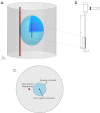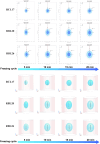Iceball growth 3D simulation model based on finite element method for hepatic cryoablation planning
- PMID: 40197246
- PMCID: PMC11978020
- DOI: 10.1186/s12876-025-03817-y
Iceball growth 3D simulation model based on finite element method for hepatic cryoablation planning
Abstract
Background: Cryoablation simulation based on Finite Element Method (FEM) can facilitate preoperative planning for liver tumors. However, it has limited application in clinical practice due to its time-consuming process and improvable accuracy. We aimed to propose a FEM-based simulation model for rapid and accurate prediction of the iceball size during the hepatic cryofreezing cycle.
Methods: A 3D simulation model was presented to predict the iceball size (frozen isotherm boundaries) in biological liver tissues undergoing cryofreezing based on the Pennes bioheat equation. The simulated results for three cryoprobe types were evaluated in the ex vivo porcine livers and clinical data. In ex vivo experiments, CT-based measurements of iceball size were fitted as growth curves and compared to the simulated results. Eight patient cases of CT-guided percutaneous hepatic cryoablation procedures were retrospectively collected for clinical validation. The Dice Score Coefficient (DSC) and Hausdorff distance (HD) were used to measure the similarity between simulation and ground truth segmentation.
Results: The measurements in the ex vivo experiments showed a close similarity between the simulated and experimental iceball growth curves for three cryoprobe models, with all mean absolute error<2.9 mm and coefficient of determination>0.85. In the clinical validation, the simulation model achieved high accuracy with a DSC of 0.87 ± 0.03 and an HD of 2.0 ± 0.4 mm. The average computational time was 23.2 s for all simulations.
Conclusion: Our simulation model achieves accurate iceball size predictions within a short time during hepatic cryoablation and potentially allows for the implementation of the preoperative cryoablation planning system.
Keywords: Cryoablation; Finite element method; Iceball simulation; Liver tumor; Preoperative planning.
© 2025. The Author(s).
Conflict of interest statement
Declarations. Ethical approval: The study was approved by the Institutional Review Board of Beijing Hospital (Beijing, China; IRB No. 2022-BJYYEC-361-01) and informed consent was waived due to the retrospective nature of our study. The study was conducted in accordance with the Declaration of Helsinki (as revised in 2013). Reporting checklist: The authors have completed the STOBE reporting checklist. Competing interests: The authors declare no competing interests.
Figures








Similar articles
-
Finite-element analysis of ex vivo and in vivo hepatic cryoablation.IEEE Trans Biomed Eng. 2007 Jul;54(7):1177-85. doi: 10.1109/TBME.2006.889775. IEEE Trans Biomed Eng. 2007. PMID: 17605348
-
GPU-based 3D iceball modeling for fast cryoablation simulation and planning.Int J Comput Assist Radiol Surg. 2019 Sep;14(9):1577-1588. doi: 10.1007/s11548-019-02051-8. Epub 2019 Aug 12. Int J Comput Assist Radiol Surg. 2019. PMID: 31407156
-
Automatic iceball segmentation with adapted shape priors for MRI-guided cryoablation.J Magn Reson Imaging. 2015 Feb;41(2):517-24. doi: 10.1002/jmri.24531. Epub 2013 Dec 12. J Magn Reson Imaging. 2015. PMID: 24338961 Free PMC article.
-
Imaging findings during and after percutaneous cryoablation of hepatic tumors.Abdom Radiol (NY). 2019 Jul;44(7):2602-2626. doi: 10.1007/s00261-019-01999-0. Abdom Radiol (NY). 2019. PMID: 31004203 Review.
-
The use of cryoablation in treating liver tumors.Expert Rev Med Devices. 2014 Jan;11(1):41-52. doi: 10.1586/17434440.2014.864551. Epub 2013 Nov 26. Expert Rev Med Devices. 2014. PMID: 24308738 Review.
References
-
- Bhardwaj N, Strickland AD, Ahmad F, Dennison AR, Lloyd DM. Liver ablation techniques: a review[J]. Surg Endosc. 2010;24(2):254–65. - PubMed
MeSH terms
Grants and funding
LinkOut - more resources
Full Text Sources
Medical

